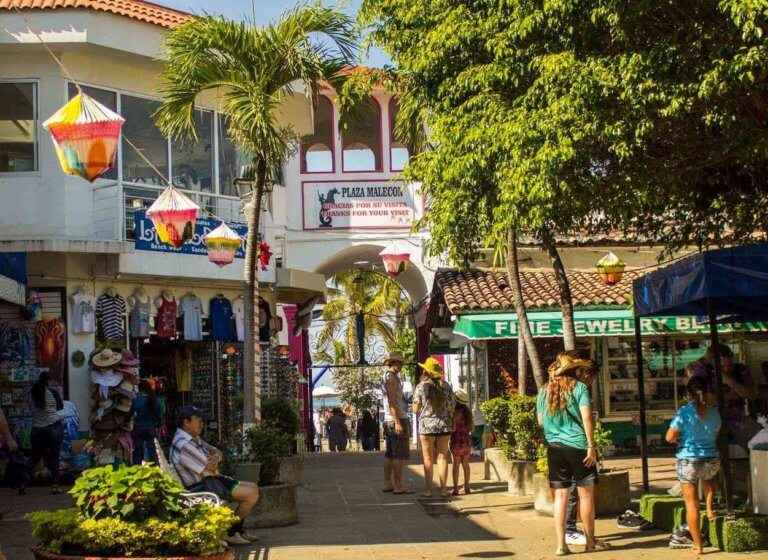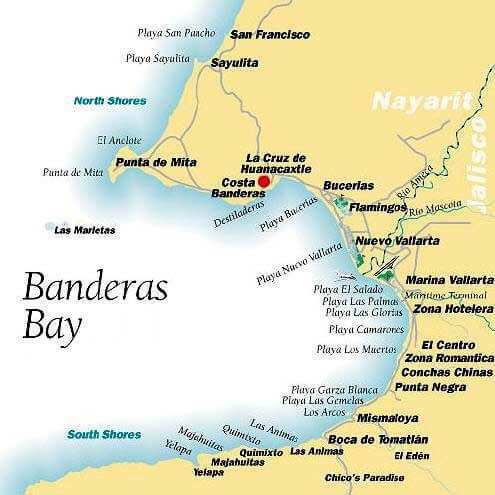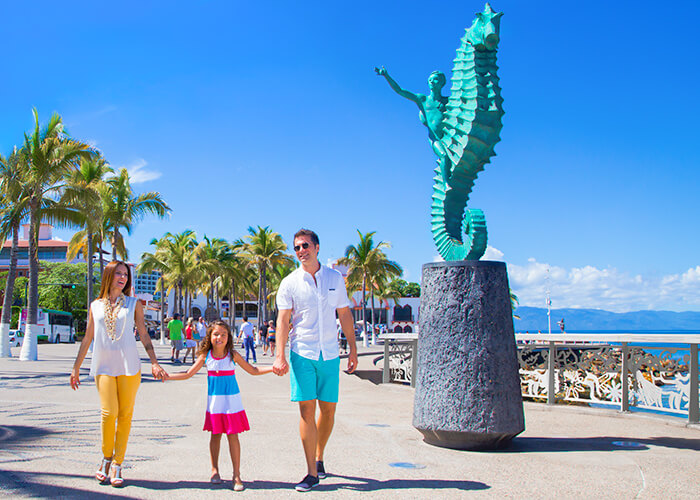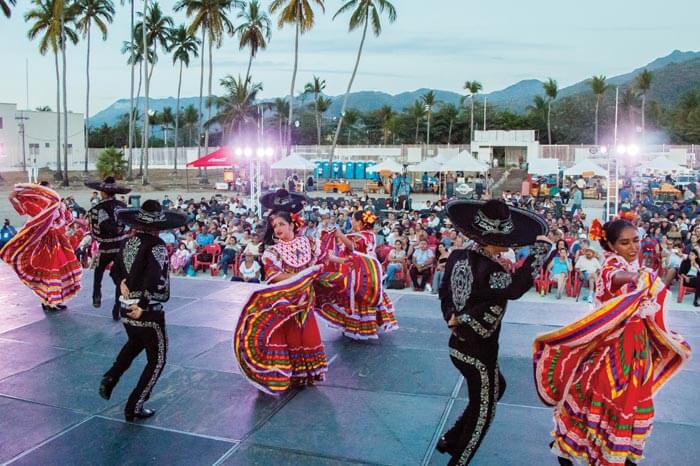Bahía de Banderas
The Municipality of Bahía de Banderas (tourist place) is one of the 20 municipalities in which the state of Nayarit, Mexico is subdivided; its head is Valle de Banderas. It is in the South Coast Region of the state. Together with the municipality of Puerto Vallarta in the State of Jalisco, it forms the Metropolitan Area of Puerto Vallarta, thus being the second most populated of both states. Likewise, the municipality is one of those with the highest population growth in the state, even higher than the central municipalities. It receives its name from the Bay of Banderasthat bathes the southern coast of the municipality and is politically divided between the states of Jalisco and Nayarit, and into which the Ameca River flows. It is the most important economic zone in the state of Nayarit. Currently, it is one of the most visited places in the country. It is an important tourist spot both nationally and internationally since it receives millions of national and foreign tourists annually, mainly from the United States, Canada and Europe, thanks to its hotels and the arrival of whales.



Name
In this region of Nayarit, there were three great chiefdoms: Tintoque, Pontoque and Tondoroque and the settlements still exist, their meaning in the Cuyuteco language is: “Tintoque”, it means “palo tinto” in the area of Brasiles, near Bucerías, ” Pontoque”, means” place near the sea or seafood area”, located in Punta de Mita and” Tondoroque “.” place of lagoons”, which is in the area of the “Quelele ” estuary….
History
The territory currently occupied by the Municipality of Bahia de Banderas was inhabited during pre-colonial times by peoples or tribes belonging to the monarchy or Hueytlahtonazgo de Xalisco, which extended southward, outside the limits of what is currently the state of Nayarit and was founded between 559 and 618. It is known that the Municipality of Bahía de Banderas was also a place of transit in the great migration that led the Aztec people to settle in the Valley of Mexico. The archaeological findings and testimonies located in Sayulita, Higuera Blanca, Punta de Mita, Valle de Banderas and San Juan de Abajo tell us about this transit, where colonies of Nahuatlaca origin existed.
It was in the year 1525 that Francisco Cortés de Buenaventura, a relative of the conqueror, arrived on these coasts, at the height of a town called Tintoc. The natives welcomed him dressed in their colorful garments and luxurious plumaria, which led to the name of the region. Subsequently, in 1530 Nuño Beltrán de Guzmán, practiced a violent and destructive colonization that caused a serious depopulation and ruin of the region, to the point that the bishop of Guadalajara said in 1605: “The Valley that they say of Banderas, was formerly the land more populated in this New Galicia and now it has nothing but small villages of little importance.
Much of the second half of the nineteenth century, the area that since the time of the conquest was called the Valley of Banderas, was preserved with a very low population density. Some of the localities that by 1893 take on some importance due to their number of inhabitants are: Valle de Banderas, with 250; San José del Valle, with 70; San Juan de Abajo, with 50; El Colomo, with 45; Mezcales, with 40; and Las Peñas, Jalisco (today Puerto Vallarta), with 60. The cultivation of corn, fishing and hunting were the activities that were practiced and were destined for self-consumption. In 1904 the Valle de Banderas Subprefecture was created and as of 1917, the Free and Sovereign State of Nayarit was constituted, it integrated the Municipality of Compostela. The current territory of Bahía de Banderas was practically oblivious to the armed confrontations that culminated in the triumph of constitutionalism and post-revolutionary struggles. In 1937, during the Cardenista period, the peasants of the region were endowed with a total of 26,648 hectares, forming 9 of the 13 ejidos that exist today. Only the one in Valle de Banderas was assigned 10,234 hectares and at least 1,433 of them were located on the other side of the Ameca River, in Jalisco territory. From 1954 to 1958, the Valle de Banderas risk unit was built, initially dominating 2,500 hectares, and later it reached an area close to 10,000 hectares, which increased agricultural production. From 1955 to 1964, tourist activity took off in small hotels located in the town of Puerto Vallarta. In 1958, the construction of the Compostela-Puerto Vallarta highway began, and it was completed ten years later, allowing the commercial opening of the Banderas Valley. From 1965 to 1974, a great international projection of Puerto Vallarta and attraction of a growing number of tourists was generated and the Nayarit portion of the Bay of Banderas, of great natural attraction, benefited indirectly. 22 In order to promote a tourist development that would benefit the agrarian communities of this coastal area of Nayarit, the Federal Government decreed in November 1970 the creation of the Bahía de Banderas Trust, whose patrimony was constituted two months later with 5,162 hectares expropriated from the ejidos of Bucerías, Jarretaderas, Cruz de Huanacaxtle, Higuera Blanca and Sayulita, among others. The trustees formed an ejido union in 1972. The promotion by the Trust marked the beginning of a process of expansion of investments and tourism infrastructure, which included the development of the Nuevo Vallarta subdivision, which, together with the surrounding coastal area, is the destination of large capitals and national and foreign visitors. Between 1975 and 1984 there was a rapid growth in the offer of accommodation in large and modern hotel facilities and full-time and time-share units; construction of new facilities such as the marina and golf course. Expansion of the hotel zone both north and south. Starting in 1985, the accelerated growth in demand, as a result of the construction of large hotels and timeshare units, has driven urban-tourist expansion with high densification in Puerto Vallarta. New tourism products in the Municipality of Bahía de Banderas that maintain the high-density model and that begin to modify the growth trends of the area (Nuevo Vallarta and Flamingos). In 1988 at the request of representative groups, who were considered marginalized by the municipal authorities.

Geography
The municipality of Bahía de Banderas is in the extreme southwest of the state of Nayarit and takes its name from the Bay of Banderas, inlet from the Pacific Ocean on the coast of Nayarit and Jalisco and on whose coasts is Puerto Vallarta.
Localities
The municipality of Bahia de Banderas has a total of 157 towns, the main ones are as follows: Mezcales, San Vicente, Bucerías, San Juan de Abajo, Valle De Banderas, Las Jarretaderas, El Porvenir, Cruz de Huanacaxtle, Sayulita, Fraccionamiento Santa Fe, Corral del Risco, Fraccionamiento Bahía de Banderas, Lo de Marcos, San Francisco (San Pancho), El Colomo, Higuera Blanca, Nuevo Vallarta, San Cemente de Lima.

Tourism
Tourism is an important economic factor for the State of Nayarit, and Bahia de Banderas is one of the main points in Nayarit. Bahía de Banderas is the main tourist pole of Nayarit and is the main part of what is known as Riviera Nayarit for its cultural expectations.

Culture
The town of Valle de Banderas, being the municipal head of Bahía de Banderas, is celebrated on February 2, the day of our Mrs. del Rosario de Tintoque. The festival consists of a daily pilgrimage through each neighborhood which carries an allegorical car with different religious images, for ten consecutive days, beginning on January 24 and until February 2. This festival is complemented by cultural festivals that take place every day at night, ending the religious act. The Blessed Virgin of Peace is also celebrated on January 24 of each year in the Bucerías chapel. On this day there is a very significant maritime procession, in which the image of the Virgin of La Paz is carried from the Cruz de Huanacaxtle to the beach of Bucérías. At noon the fishermen and seamen come to it to be blessed with protection and good fishing. In the town of San José del Valle, the festivities are from March 10 to 19, celebrating Mr. San José; each day consists of making a pilgrimage through each sector until reaching the town’s temple. In this pilgrimage, floats with religious images are shown throughout the novena. Cultural festivals are also held after the pilgrimage where dancing and singing competitions are shown; queen and king of spring are chosen; and is enlivened with musical groups and orchestras. Several popular festivals are celebrated where the “May Festivities” stand out, which are the patron saint festivities of San Juan de Abajo, celebrating San Juan Bautista; the festivities begin on May 15th and end on May 24th. This is the largest fair in the municipality of Bahía de Banderas. As well as El Porvenir, they are celebrated 2 times a year, October 16 (ejidal) and December 8 (employers’). On October 16 the largest communal celebration of the entire municipality is celebrated, beginning with its already traditional mass in the church of La Purísima Concepción, giving breakfast to all the people of said town, followed by a beautiful and great parade of costumes, music, dance, and dance, followed by this the ejidal commission gives a delicious meal with Mexican snacks to all those present to finish with a great dance. On December 8, celebrating the patron saint festivities of the patron saint, “La purísima Concepción” the
festivities begin on November 31 with their beautiful pilgrimages and floats, beauty contests, singing, dancing, all of this enlivened by groups, mariachis, bands, and musical orchestras. Ending on December 8


